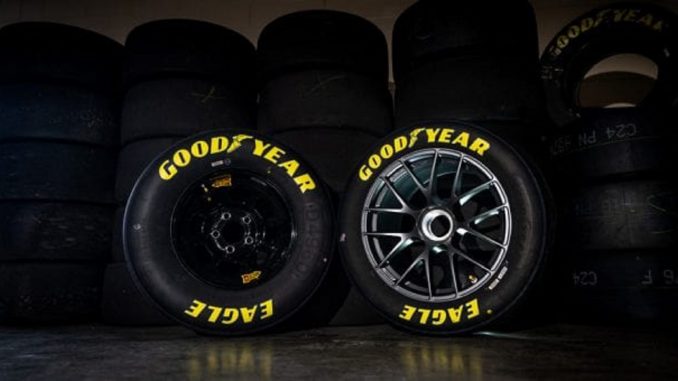
NASCAR will take another step towards modernization with the debut of the Next Gen car in 2021. Officials confirmed Monday that the new cars will have 18-inch aluminum wheels replacing the current 15-inch steel wheels, and that for the first time a single lug nut will be used instead of the traditional five.
The new configuration made its debut during a test at Auto Club Speedway of the new car Monday. The three prior tests used the large aluminum wheels but kept the five-lug configuration.
“One of our main goals with the Next Gen car is to provide a vehicle that better replicates what our OEM partners sell in the showroom – both in looks and relevant technology,” John Probst, NASCAR Senior Vice President of Innovation and Racing Development said. “Moving to an 18” forged aluminum wheel helps do just that.
“Once the decision was made to go that direction, we tested different lug nut options. With the loads on the larger wheels, we had to make sure that the wheel would remain securely fastened the car. The single lug, center lock design was the best way to accomplish this.”
The wheels being used in testing were made by BBS, a German-based company that has its American headquarters in Braselton, Georgia. The wheelmaker has a long history in motorsports, particularly in IMSA and other forms of sports-car racing.
While the used of one lug nut instead of five will change pit stops, Probst and competition officials do not expect wholesale changes to the execution of pit stops, the five-person limit on crew members who go over the wall or team rosters overall.
“I think from a fan standpoint, the choreography of the pit stop will look unchanged,” Probst said. “I think that a lot of times when we say single lug nut, people fear that it’s an open-wheel style pit stop where people will be on their knees waiting for the car to come in. We don’t intend to change anything with respect to how the pit-stop flow is executed.
“There will still be guys coming off the wall, there will still be a premium for that athlete to come off the wall, get to the right side of the car, make that tire change, get over to the left side of the car and make the tire change. From the look and feel of the pit stop, we don’t see any significant changes.”
The choreography of the pit stop will remain the same and Probst said crew members won’t be able to change tires in the new setup in one-fifth of the time it takes now since the new, larger single lug will require more torque to properly fasten the wheel.
“On the on and off, they still have to keep the gun on — they can’t just cap it, it’s got to actually ratchet a few times before it actually gets tight,” Probst said. “So today, good tire changers can take five lug nuts off or put them on in less than a second, say eight-tenths of a second to a second. They’re going to have to leave the gun on for probably at least a half a second, so if anything, they may be three-tenths (quicker) here and there, but it shouldn’t dramatically change the timing on the pit stop.”
That extra torque needed with the single larger lug nut will be critical, especially with just one contact point for the wheel. In the current five lug system, the likelihood that one or more of those lug nuts aren’t tight when changing tires quickly in race conditions is greater.
“The steel wheel is more forgiving and can handle loose wheels a little bit better,” Probst said. “When we get to the aluminum wheel, we did some durability studies and if you leave lug nuts loose on an aluminum wheel, you reduce the durability of the wheel by around 30%. It’s more of, the aluminum wheel has less tolerance to loose lug nuts, so when we have one, there really is only one thing to concentrate on, and that is to get that lug nut tight. Then everything else from a durability standpoint is fine.”
The new wheels will also free up a great deal or pre-race work for the crews. Crewmembers can often be seen gluing lug nuts, five to a tire, on each set of tires used during a weekend. This can amount to thousands of manhours. This will be eliminated with the new wheels.
“One of the things when you look at the single nut, it actually is retained in the socket, so they’ll actually use the same single wheel nut for the entire race and likely multiple races,” Probst said. “They’ll use the same lug the entire time, so the concept of gluing lug nuts to tires goes away, which creates some efficiencies for us. There’s times when we have to open up the garage or pit road early on race day for no other reason than for the race teams to glue up 11 sets of tires. They can just use the wheels as they are without being glued.”
- Biffle, Dorton, Sprague join NASCAR Hall of Fame Class of 2025 nominees for the first time - April 24, 2024
- NASCAR will experiment with different tire compounds for the first time at All-Star Race - April 23, 2024
- Legacy Motor Club reserve driver Corey Heim to sub for Erik Jones at Dover - April 23, 2024